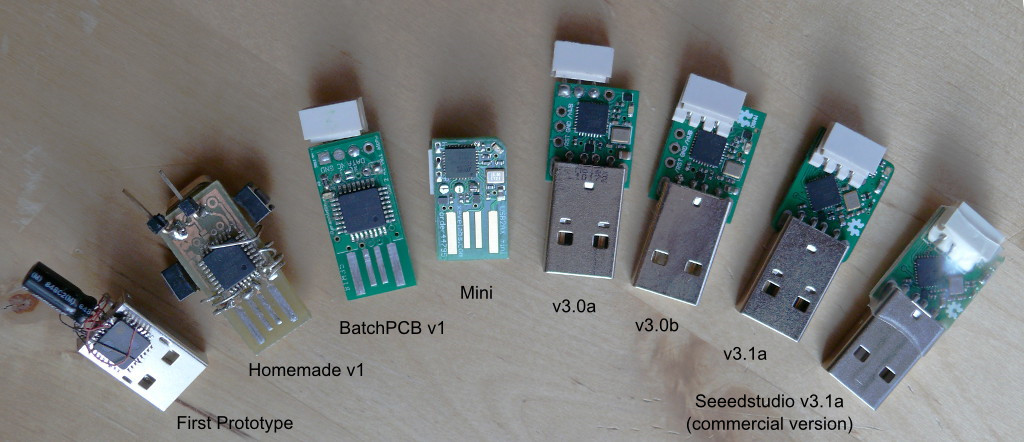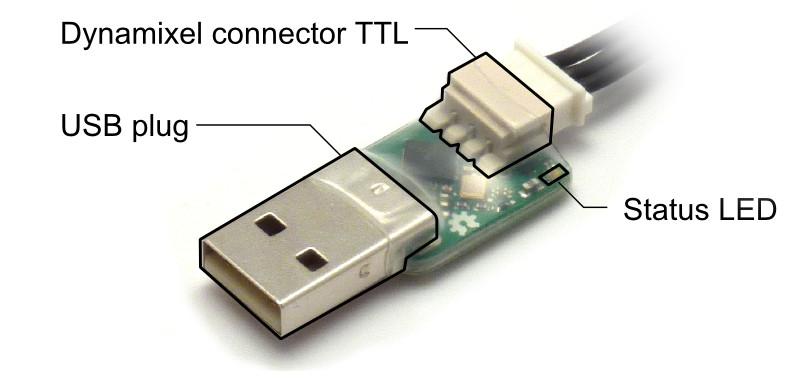User Tools
Table of Contents
Product: USB2AX
What is the USB2AX?
The USB2AX is a small interface to control Dynamixel servomotors like the AX-12 from a computer. It plugs into a USB port and has a 3-pin Dynamixel connector to be connected to the servos.
If you're in a hurry, jump to Quickstart !
Documentation en Français sur le Wiki de Cybedroïd (merci!)
☛ To fix problems experienced with Dynamixel 2.0 packets returning errors or Dynamixel Wizard freezing, please update the firmware ☚ Last updated 27 July 2017.
If you still have problems, send an email to: contact@xevelabs.com
Status LED: the LED lights up GREEN when the USB2AX is ready, RED if not (no driver, USB authentication error…).
The pads and jumper under the PCB are detailed in the GPIO and SPI page.
What is it useful for then?
The USB2AX is a direct way to control servos to move legs, arms or claws in a robot with an embedded computer (laptop or Raspberry PI for example).
You can also use it as a tool to setup, diagnose or fix your servos.
Have a look at some examples of application!
What servos can it talk to?
The USB2AX can talk with the Dynamixel servos which use a half-duplex TTL interface (3-pins connector).
More specifically:
- All of the AX servos (AX-12/AX-12+/AX-12A, AX-12W, AX-18F/AX-18A).
- The “T” versions of the MX servos (MX-28T, MX-64T, MX-106T).
- The “T” versions of the XM servos (XM430-W350-T, XM430-W210-T) - but with an adapter, as the connector are not directly compatible
- XL-320 - but with an adapter, as the connector are not directly compatible
Features
- Communication with AX and MX Dynamixel servos (with 3 wires) @ 1Mbps
- Very small (16x36mm)
- Optimized latency
- Windows / Linux / MacOS
- Compatible with RoboPlus, Dynamixel SDK, ROS, Python, C/C++/C#, Visual Basic, Java, Labview, Matlab…
- Open Source Software & Hardware, programmable and hackable!
What are the limitations?
Fortunately, the USB2AX can not do everything ![]()
- The USB2AX can not communicate with the Dynamixel servos using the RS485 interface (the one with 4 pins).
- Neither can it control any sort of hobby/RC servos or other brand of robot servos.
- Compared to the USB2Dynamixel, it also lacks the RS232 port (with its big DB9 connector) used to program some controllers from Robotis like the CM-510.
- It can not supply power to the servos (see Q: How to power the servos).
- It is not a generic USB to Serial (even though it can be modified to be one) and has very different capabilities than the LN-101.
- The USB2AX reserves the ID 0xFD, so it cannot be used by a servo on the bus.
- It does not make coffee, but could be used to create a robot that does!
- For NI Labview users experiencing problems (including BSOD), see the FAQ.
Quickstart
Read the Quickstart Guide, and be on your way ![]()
For Linux users, have a look at the FAQ too for some additional “gotchas”.
To go further...
More information for everyone:
Some more stuff for power-users:
Advanced topics to use the full potential of the hardware for your specific application!
Miscellaneous
History
 First prototypes,
v1.0,
v3.0a,
v3.0b,
USB2AX Mini,
v3.1a.
First prototypes,
v1.0,
v3.0a,
v3.0b,
USB2AX Mini,
v3.1a.
v2 never saw the light of day, it was very similar to v1 and scraped when I realized it was going to be much bigger than v1. Instead, I went on with v3 that used smaller components (0402 passives instead of 0603, QFN instead of QFP for the ATmega).
And finally the commercial v3.1a, which differs from the original v3.1a only by its corners: they were rounded, they are now square for manufacturing reasons.
v3.2a that went on sale on Mai 2014 is a slightly more rationalized version of the 3.1a, witch uses more of the Seeedstudio Open Part Library components in place of more expensive and difficult to source ones (crystal and LEDs mostly).
Examples of projects using USB2AX
Xachikoma by Xevel, the four-legged reason for creating the USB2AX. 4 legs, 5DOF each, plus powered wheels instead of feet.
Aria by Cybedroïd, a life-size humanoid robot.
Charlotte by KevinO, an hexapod controlled with a Raspberry Pi through an USB2AX.
HexaWheels by Siempre Aprendiendo, an hexapod with wheels and a Raspberry Pi.
Glider by Nick Donaldson of http://gotrobots.com, a big hexapod using MX-64T and a USB2AX, with free wheels to move like the Roller-Walker!
Golem by KevinO, a big hexapod using an Intel NUC.
3D printed leg prototype by HXP2, using MX-28T and an ODROID-U3.
demo with BeagleBone Black by bloftin3000.
USB2AX on the web
Xevelabs, Xevel's blog.
Fourwalledcubicle, Dean Camera's blog.
PoBot (FR), a review by the French robotics association PoBot.
Acknowledgments
Contributors:
Nicolas Saugnier (Xevel) - Idea, original schematics, firmware, and - starting from v3.0 - everything else .
Julien Le Guen (JLG) - Eagle schematics and routing of first versions.
Richard Ibbotson (iBot) - optimization of the code for lower latency, improvements to the schematics, implementation of advanced functionalities.
Thanks:
Dean Camera for making the greatest USB library for AVR, LUFA.
Weston T. Schmidt for making the cross-platform app DFU-Programmer!
Cybedroïd pour la documentation en Français / for documentation in French.
Trossen Robotics, Robosavvy, SeeedStudio and Adafruit for the help (direct or indirect) to bring the USB2AX to market.
Inspirations:
Arbotix RoboController
Arduino Uno
Adafruit ATmega32u4 Breakout Board
Ruggeduino, for over-voltage protection on DATA
Download / files
- Driver for Windows (signed Nov2017): USB2AX.inf (no need for a driver on Linux and MacOS)
- Firmware sources, Eagle files for the PCB: (new) GitHub repository
- STL 3D model of the USB2AX v3.1a board
- File for a 3D printed case

Where to buy?
The USB2AX is available via multiple distributors, see the Start page.
For any comment or question: contact@xevelabs.com




